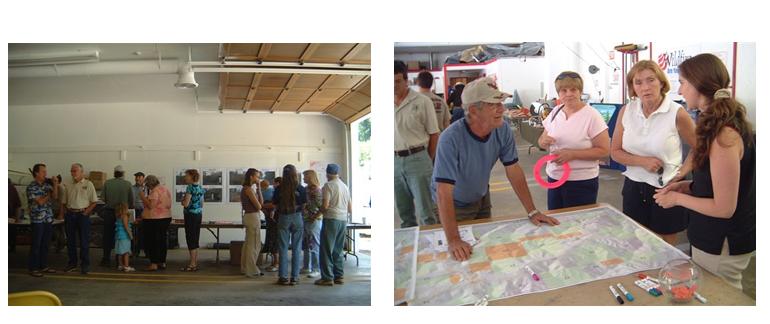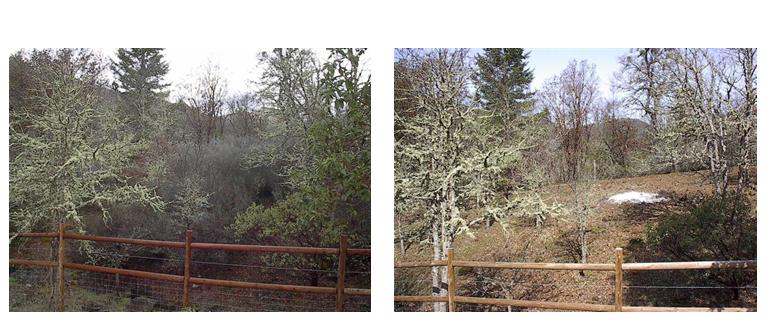The national database of state and local wildfire hazard mitigation programs
serves as a clearinghouse of information about nonfederal policies and
programs that seek to reduce the risk of loss of life and property through
the reduction of hazardous fuels on private lands. If
you would like to submit a program to the national wildfire programs database,
please complete the following form (MS
Word).
Return to your search results or Perform a new search
|
Title: |
Josephine County Integrated Fire Plan, OR
|
|
Type: |
Education
Designation of high risk areas
Community Planning
|
|
Jurisdiction: |
County
|
|
State: |
Oregon
|
|
Program Description: |
Josephine County Integrated Fire Plan, Oregon
The Josephine County Integrated Fire Plan is one of the first Community Wildfire Protection Plans prepared to meet the requirements of the Healthy Forest Restoration Act. The Plan addresses the fire hazard and fuel reduction needs of the Josephine County, a large and heavily forested county located just north of California, in southwestern Oregon.
The Josephine County Integrated Fire Plan (JCIFP) is multi-jurisdictional and addresses wildfire risk and mitigation actions for the two municipalities of Grants Pass and Cave Junction, the four rural fire protection districts: Applegate Valley, Illinois Valley, Williams, and Wolf Creek, as well as the unprotected areas of Josephine County, largely served by the Rural/Metro Fire Department. The Fire Plan was presented to the Josephine County Board of Commissioners and adopted on November 8, 2004, and also signed by the Oregon Department of Forestry and the Josephine County Fire Defense Board. The Plan was developed by these three entities in collaboration with the BLM, Medford District, Rogue River � Siskiyou National Forest, and all the local fire districts, community response teams, and many other local organizations. To view the Fire Plan, visit www.co.josephine.or.us/wildfire/.
Committee Structure
The planning committee broke into five sub-committees to develop objectives and implement actions. These are:
Executive Committee - for general goal setting, representation and oversight;
Risk Assessment - to identify communities at risk and the wildland-urban interface, conduct the risk assessment and identify and prioritize hazardous fuels treatment projects;
Fuels Reduction - to identify strategies for coordinating fuels treatment projects, administer grants for fuels reduction across fire districts, provide special need citizens with an opportunity to participate in programs, and identify opportunities for biomass marketing and utilization;
Emergency Management - to strengthen emergency management, response and evacuation and build relationships between county government and local fire districts;
Education and Outreach - to develop strategies for increasing citizen awareness and action for fire prevention, and to reach out to all citizens of the county.
Wildfire Risk Assessment
Using maps to identify cumulative risks occurring in the landscape, the risk assessment identifies Communities-at-Risk and the Wildland-Urban Interface by taking into account a combination of factors including:
Risk - potential and frequency for wildfire ignitions based on past occurrences;
Hazards � Ecological conditions that contribute to wildfire including fuels, slope, aspect, elevation and weather;
Values - locations of people, property, natural and other resources that could suffer losses in a wildfire event;
Protection Capability - ability to respond to and suppress wildland and structural fires;
Structural Vulnerability � roof type and building materials, access to the structure and whether or not there is defensible space or fuels reduction around the structure.
Based on the locations of the Communities-at-Risk identified through this process, strategic planning units based on watersheds were designated to create a preliminary list of fuels treatment projects. Parameters for prioritizing projects are established and listed in the JCIFP. Projects were then prioritized to address the risk equitably across the landscape.
Education and Outreach
The JCIFP includes a detailed framework for developing a complex education and outreach program for 2004 and beyond. The program takes advantage of some of the strong programs already existing in the district including the Rogue Valley Fire Prevention Coop (RVFPC) which unites agencies involved in fire prevention and the Siskiyou Field Institute which is creating an interactive online learning center about fuels reduction and fire planning aimed at youth education. The JCIFP Education and Outreach Committee worked with the RVFPC to design a new logo promoting wildfire preparedness in Josephine County and neighboring Jackson County. In 2005, the committee is launching a campaign called, "Wildfire: Are You Prepared?" using flyers, logos and posters, developing in-school programs and coordinating mobile displays to present fire plan information at community events and fairs throughout Josephine County. The committee has also created a recognition program in Josephine and Jackson Counties for homes that meet the counties� standards for wildfire safety. The Applegator Newspaper in Applegate Valley has been providing special semi-annual fire issues for several years. The Education Committee will coordinate with the Applegator to bring this same information to the entire county.
Other outreach activities include maintaining resource clearinghouses at libraries, rural fire protection districts and video stores, and coordinating free dump days at the landfill for slash from yard clean-up.
2004 Survey Results
The 2004 Josephine County Survey conducted the Oregon Survey Research Laboratory asked several questions relating to perceptions and preparations for wildfire. The random sample telephone survey resulted in the following statistics about fire:
- 67% of respondents reported that they believe their community is at risk for wildfire;
- 42% of respondents believe their home is at risk to wildfire;
- 54% of respondents are familiar with fire evacuation procedures in their area;
- 18% of respondents have participated in Oregon Department of Forestry�s Homeowner Fuel Reduction Program;
- Almost 95% of respondents indicated that they remove brush and other flammable material from their property each year;
- 46% of respondents live in homes built with fire resistant building materials;
- 70% think government should require that new homes be built with fire resistant materials.
Monitoring and Evaluation
The JCIFP provides for monitoring to track implementation and to evaluate how well the goals of the fire Plan are being met over time. Each element of the Fire Plan � risk assessment, fuels reduction, emergency management, and education and outreach � provides monitoring tasks for recommended action items. The JCIFP planning committee will administer annual evaluations of the fire planning process and the annual Josephine County survey will include questions about awareness and progress of actions. Josephine County will post the results of these evaluations on the JCIFP website.
Contact Information
For more information, contact:
Mark Sorensen, Josephine County
510 NW 4th Street
Grants Pass, OR 97526
Tel: (541)474-5426
Email: [email protected]
or
Kathy Lynn, Resource Innovations
c/o Institute for Sustainable Environment
5247 University of Oregon
Eugene, OR 97403-5247
Work: (541) 346-0687
Email: [email protected]
|
|
Images: |
|
1. | 
|
|
Wolf Creek Fire District Community Fire Planning Meeting, July 2004.
|
|
2. | 
|
|
Scott Fuels Reduction Project - Before/After - Oregon Department of Forestry.
|
|
|



